Pests
Diamondback moth (Plutella xylostella)
The caterpillars feed on the leaf epidermis and later make holes in the leaves.
Severely affected leaves are completely skeletonised.
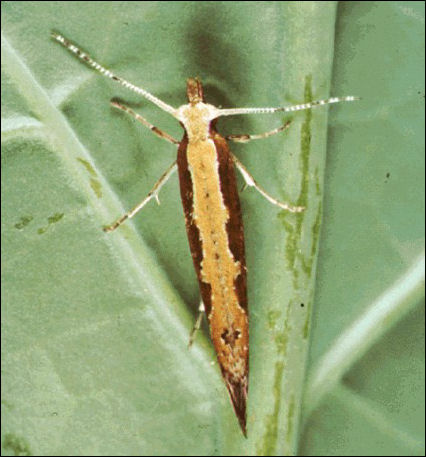
Control: Spraying malathion (0.1%)
and trap cropping with mustard controls the pest.
Leaf webber (Crocidolomia binotalis)
Caterpillars web up the leaves and live inside the knotted mass affecting flowering
and pod formation adversely.
Control: Removal and destruction
of webbed bunches of leaf and dusting the crop with quinalphos 0.25% or spraying with
malathion (0.05%) is effective.
Cabbage borer (Hellula undalis)
The caterpillars mine the foliage, feed on the shoots and finally bore into the
stem; and the infested plants get killed or produce side shoots, which do not form
heads.
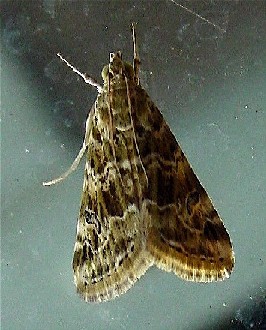
Control: Spraying the crop with
malathion (0.1%) or dusting 4% carbaryl gives good control of the larvae.
Cabbage butterfly (Pieris brassicae)
The larvae feed gregariously on the foliage and burrow into the heads, making it
unfit for marketing.
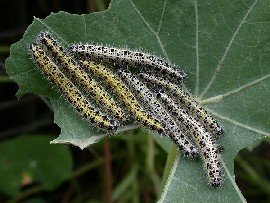
Control: The caterpillars should
be hand picked and destroyed. Spraying malathion (0.1%) or carbaryl (0.15%) gives
excellent control of the pest.
Aphids (Brevicoryne brassicae, Myzus persicae,
Lipaphis erysimi)
Nymphs and adults suck cell sap devitalizing the plants and the affected parts become
discoloured and malformed.
Control: Spraying of malathion (0.1%).
The insecticide application should be stopped 15-20 days before harvest.
Diseases
Stalk rot (Sclerotinia sclerotiorum)
This disease causes serious loss in the field, storage, under transit and market
conditions. The infections begin as circular water soaked areas, which become soft
and watery as the disease progresses, and damage the entire cabbage head.
Control: Avoid planting cabbage
and other susceptible crops in fields infested with white mold. Mechanical injuries
to cabbage heads during harvesting operations should be avoided.
Black rot (Xanthomonas campestris pv.
campestris)
The infected tissue turns brown and dies, and severely affected leaves drop off.
The infected stems and roots become black. The heads of the infected plants remain
small and its quality is reduced making it unfit for consumption.
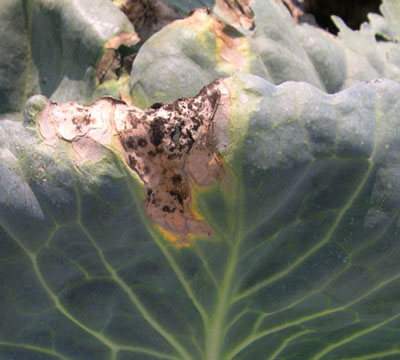
Control: Avoiding continuous cropping
of crucifers in the same field and use of resistant varieties offer good control.
Treat the seeds with streptocycline ( 300ppm).
Weekly application of Pseudomonas fluorescence 2% solution after the head initiation also controls the disease.
Downy mildew (Perenospora parasitica)
Small, light green-yellow lesions on the upper leaf surface, later a grayish white
moldy growth is developed on the undersurface of the leaf, and the leaf eventually
becomes papery and die. Cabbage heads develop sunken black spots.
Control: Removal of weeds and alternate
hosts and spraying with copper oxychloride (0.3%) are effective in controlling the
disease.
Leaf spot and blight (Alternaria brassicae
and A. brassiciola)
Small dark yellow spots appear on the leaf surface, which later enlarge to form
circular areas with concentric rings surrounded by yellow halos. In severe cases,
the entire plant defoliates.
Control: Use of disease free seeds,
practicing proper crop rotation and seed treatment with hot water (50° C for
30 minutes) helps to minimize the disease incidence.
Yellows or fusarium wilt (Fusarium
oxysporum f. sp conglutinans)
Initially the lower leaves and later the upper leaves turn yellow, wilt and die.
With time, the dead leaves turn brown and the affected tissue becomes dry and brittle.
Control: Use of resistant varieties
and very early sowing of cabbage can minimize the disease incidence.
Black leg (Phoma lingum)
Irregular spots develop on leaves and stem, which extend below the soil surface,
causing black rot of lower stem and roots. Severely affected plants remain stunted
and finally wilt, and under favourable condition the disease causes severe yield
loss.
Control: Use of disease free seeds
and hot water treatment of seeds is recommended to control the disease.
Club root (Plasmodiophora brassicae)
Roots of the infected plants develop club like swellings. Plants infected in the
nursery get killed, whereas those attacked at a later stage wilt in hot weather
but partly recover at night. Finally leaves become stunted, yellowish and prematurely
bolt in hot weather.
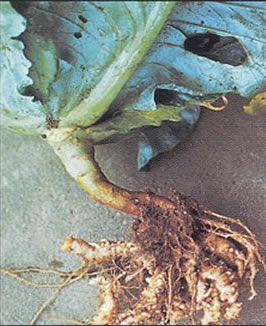
Control: Crop rotation of more than
6 years and mixing finely ground limestone before planting help to reduce disease
incidence.Incidence of this can be managed by weekly hoeing. Drenching with Pseudomonas fluorescence 2%
controls the disease.
Damping off (Pythium debaryanum)
Seedlings develop lesion near the collar region and tissue beneath become soft due
to which seedling collapse and die.
Control: Seed treatment with Trichoderma
viride (3-4 g/kg of seed) and soil drenching
with dithane M 45 (0.2%) or bavistin (0.1%) afford protection against the disease.
Top
|